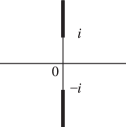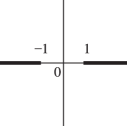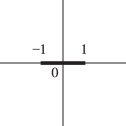§4.37 Inverse Hyperbolic Functions ‣ Hyperbolic Functions ‣ Chapter 4 Elementary Functions (original) (raw)
Contents
- §4.37(i) General Definitions
- §4.37(ii) Principal Values
- §4.37(iii) Reflection Formulas
- §4.37(iv) Logarithmic Forms
- §4.37(v) Fundamental Property
- §4.37(vi) Interrelations
§4.37(i) General Definitions
The general values of the inverse hyperbolic functions are defined by
| 4.37.1 | Arcsinhz | =∫0zdt(1+t2)1/2, |
|---|---|---|
| ⓘ Defines: Arcsinhz: general inverse hyperbolic sine function Symbols: dx: differential of x,∫: integral andz: complex variable Referenced by: §4.37(i),§4.37(ii) Permalink: http://dlmf.nist.gov/4.37.E1 Encodings: TeX, pMML, png See also: Annotations for §4.37(i),§4.37 andCh.4 | ||
| 4.37.2 | Arccoshz | =∫1zdt(t2−1)1/2, |
| ⓘ Defines: Arccoshz: general inverse hyperbolic cosine function Symbols: dx: differential of x,∫: integral andz: complex variable Referenced by: §4.37(i) Permalink: http://dlmf.nist.gov/4.37.E2 Encodings: TeX, pMML, png See also: Annotations for §4.37(i),§4.37 andCh.4 | ||
| 4.37.3 | Arctanhz | =∫0zdt1−t2, |
| z≠±1, | ||
| ⓘ Defines: Arctanhz: general inverse hyperbolic tangent function Symbols: dx: differential of x,∫: integral andz: complex variable Referenced by: §4.37(i),§4.37(ii) Permalink: http://dlmf.nist.gov/4.37.E3 Encodings: TeX, pMML, png See also: Annotations for §4.37(i),§4.37 andCh.4 | ||
| 4.37.4 | Arccschz | =Arcsinh(1/z), |
| ⓘ Defines: Arccschz: general inverse hyperbolic cosecant function Symbols: Arcsinhz: general inverse hyperbolic sine function andz: complex variable Permalink: http://dlmf.nist.gov/4.37.E4 Encodings: TeX, pMML, png See also: Annotations for §4.37(i),§4.37 andCh.4 | ||
| 4.37.5 | Arcsechz | =Arccosh(1/z), |
| ⓘ Defines: Arcsechz: general inverse hyperbolic secant function Symbols: Arccoshz: general inverse hyperbolic cosine function andz: complex variable Permalink: http://dlmf.nist.gov/4.37.E5 Encodings: TeX, pMML, png See also: Annotations for §4.37(i),§4.37 andCh.4 | ||
| 4.37.6 | Arccothz | =Arctanh(1/z). |
| ⓘ Defines: Arccothz: general inverse hyperbolic cotangent function Symbols: Arctanhz: general inverse hyperbolic tangent function andz: complex variable Permalink: http://dlmf.nist.gov/4.37.E6 Encodings: TeX, pMML, png See also: Annotations for §4.37(i),§4.37 andCh.4 |
In (4.37.1) the integration path may not pass through either of the points t=±i, and the function (1+t2)1/2 assumes its principal value when t is real. In (4.37.2) the integration path may not pass through either of the points ±1, and the function(t2−1)1/2 assumes its principal value when t∈(1,∞). Elsewhere on the integration paths in (4.37.1) and (4.37.2) the branches are determined by continuity. In (4.37.3) the integration path may not intersect ±1. Each of the six functions is a multivalued function of z. Arcsinhz andArccschz have branch points at z=±i; the other four functions have branch points at z=±1.
§4.37(ii) Principal Values
The principal values (or principal branches) of the inversesinh, cosh, and tanh are obtained by introducing cuts in the z-plane as indicated in Figure 4.37.1(i)-(iii), and requiring the integration paths in (4.37.1)–(4.37.3) not to cross these cuts. Compare the principal value of the logarithm (§4.2(i)). The principal branches are denoted by arcsinh,arccosh, arctanh respectively. Each is two-valued on the corresponding cut(s), and each is real on the part of the real axis that remains after deleting the intersections with the corresponding cuts.
The principal values of the inverse hyperbolic cosecant, hyperbolic secant, and hyperbolic tangent are given by
| 4.37.7 | arccschz | =arcsinh(1/z), |
|---|---|---|
| ⓘ Defines: arccschz: inverse hyperbolic cosecant function Symbols: arcsinhz: inverse hyperbolic sine function andz: complex variable A&S Ref: 4.6.4 Referenced by: §4.37(iv),§4.45(i),§4.45(ii) Permalink: http://dlmf.nist.gov/4.37.E7 Encodings: TeX, pMML, png See also: Annotations for §4.37(ii),§4.37 andCh.4 | ||
| 4.37.8 | arcsechz | =arccosh(1/z). |
| ⓘ Defines: arcsechz: inverse hyperbolic secant function Symbols: arccoshz: inverse hyperbolic cosine function andz: complex variable A&S Ref: 4.6.5 Permalink: http://dlmf.nist.gov/4.37.E8 Encodings: TeX, pMML, png See also: Annotations for §4.37(ii),§4.37 andCh.4 | ||
| 4.37.9 | arccothz | =arctanh(1/z), |
| z≠±1. | ||
| ⓘ Defines: arccothz: inverse hyperbolic cotangent function Symbols: arctanhz: inverse hyperbolic tangent function andz: complex variable A&S Ref: 4.6.6 Referenced by: §4.37(iv),§4.45(i),§4.45(ii) Permalink: http://dlmf.nist.gov/4.37.E9 Encodings: TeX, pMML, png See also: Annotations for §4.37(ii),§4.37 andCh.4 |
These functions are analytic in the cut plane depicted in Figure4.37.1(iv), (v), (vi), respectively.
Except where indicated otherwise, it is assumed throughout the DLMF that the inverse hyperbolic functions assume their principal values.
 |
 |
 |
|---|---|---|
| (i) arcsinhz | (ii) arccoshz | (iii) arctanhz |
 |
 |
 |
| (iv) arccschz | (v) arcsechz | (vi) arccothz |
Figure 4.37.1: z-plane. Branch cuts for the inverse hyperbolic functions.Magnify
Graphs of the principal values for real arguments are given in §4.29. This section also indicates conformal mappings, and surface plots for complex arguments.
§4.37(iii) Reflection Formulas
§4.37(iv) Logarithmic Forms
Throughout this subsection all quantities assume their principal values. For more concrete principal branch expressions for inverse hyperbolic functions see Dempsey (2025).
Inverse Hyperbolic Sine
| 4.37.16 | arcsinhz=ln((z2+1)1/2+z), |
|---|---|
| z/i∈ℂ∖(−∞,−1)∪(1,∞); | |
| ⓘ Symbols: ℂ: complex plane,∈: element of,arcsinhz: inverse hyperbolic sine function,i: imaginary unit,lnz: principal branch of logarithm function,(a,b): open interval,∖: set subtraction,∪: union andz: complex variable Permalink: http://dlmf.nist.gov/4.37.E16 Encodings: TeX, pMML, png See also: Annotations for §4.37(iv),§4.37(iv),§4.37 andCh.4 |
compare Figure 4.37.1(i). On the cuts
| 4.37.17 | arcsinh(iy)=12πi±ln((y2−1)1/2+y), |
|---|---|
| y∈[1,∞), | |
| ⓘ Symbols: π: the ratio of the circumference of a circle to its diameter,[a,b): half-closed interval,∈: element of,arcsinhz: inverse hyperbolic sine function,i: imaginary unit,lnz: principal branch of logarithm function andy: real variable Permalink: http://dlmf.nist.gov/4.37.E17 Encodings: TeX, pMML, png See also: Annotations for §4.37(iv),§4.37(iv),§4.37 andCh.4 |
| 4.37.18 | arcsinh(iy)=−12πi±ln((y2−1)1/2−y), |
|---|---|
| y∈(−∞,−1], | |
| ⓘ Symbols: π: the ratio of the circumference of a circle to its diameter,∈: element of,arcsinhz: inverse hyperbolic sine function,i: imaginary unit,lnz: principal branch of logarithm function,(a,b]: half-closed interval andy: real variable Permalink: http://dlmf.nist.gov/4.37.E18 Encodings: TeX, pMML, png See also: Annotations for §4.37(iv),§4.37(iv),§4.37 andCh.4 |
the upper/lower signs corresponding to the right/left sides.
Inverse Hyperbolic Cosine
| 4.37.19 | arccoshz=ln(±(z2−1)1/2+z), |
|---|---|
| z∈ℂ∖(−∞,1), | |
| ⓘ Symbols: ℂ: complex plane,∈: element of,arccoshz: inverse hyperbolic cosine function,lnz: principal branch of logarithm function,(a,b): open interval,∖: set subtraction andz: complex variable Referenced by: §4.37(iv),§4.37(iii),§4.37(iv) Permalink: http://dlmf.nist.gov/4.37.E19 Encodings: TeX, pMML, png See also: Annotations for §4.37(iv),§4.37(iv),§4.37 andCh.4 |
the upper or lower sign being taken according as ℜz≷0; compare Figure 4.37.1(ii). Also,
| 4.37.20 | arccosh(iy)=±12πi+ln((y2+1)1/2±y), |
|---|---|
| y≷0. | |
| ⓘ Symbols: π: the ratio of the circumference of a circle to its diameter,arccoshz: inverse hyperbolic cosine function,i: imaginary unit,lnz: principal branch of logarithm function andy: real variable Referenced by: §4.37(iv) Permalink: http://dlmf.nist.gov/4.37.E20 Encodings: TeX, pMML, png See also: Annotations for §4.37(iv),§4.37(iv),§4.37 andCh.4 |
It should be noted that the imaginary axis is not a cut; the function defined by (4.37.19) and (4.37.20) is analytic everywhere except on (−∞,1]. Compare Figure 4.37.1(ii).
An equivalent definition is
| 4.37.21 | arccoshz=2ln((z+12)1/2+(z−12)1/2), |
|---|---|
| z∈ℂ∖(−∞,1); | |
| ⓘ Symbols: ℂ: complex plane,∈: element of,arccoshz: inverse hyperbolic cosine function,lnz: principal branch of logarithm function,(a,b): open interval,∖: set subtraction andz: complex variable Permalink: http://dlmf.nist.gov/4.37.E21 Encodings: TeX, pMML, png See also: Annotations for §4.37(iv),§4.37(iv),§4.37 andCh.4 |
see Kahan (1987).
On the part of the cuts from −1 to 1
| 4.37.22 | arccoshx=±ln(i(1−x2)1/2+x), |
|---|---|
| x∈(−1,1], | |
| ⓘ Symbols: ∈: element of,arccoshz: inverse hyperbolic cosine function,i: imaginary unit,lnz: principal branch of logarithm function,(a,b]: half-closed interval andx: real variable Permalink: http://dlmf.nist.gov/4.37.E22 Encodings: TeX, pMML, png See also: Annotations for §4.37(iv),§4.37(iv),§4.37 andCh.4 |
the upper/lower sign corresponding to the upper/lower side.
On the part of the cut from −∞ to −1
| 4.37.23 | arccoshx=±πi+ln((x2−1)1/2−x), |
|---|---|
| x∈(−∞,−1], | |
| ⓘ Symbols: π: the ratio of the circumference of a circle to its diameter,∈: element of,arccoshz: inverse hyperbolic cosine function,i: imaginary unit,lnz: principal branch of logarithm function,(a,b]: half-closed interval andx: real variable Permalink: http://dlmf.nist.gov/4.37.E23 Encodings: TeX, pMML, png See also: Annotations for §4.37(iv),§4.37(iv),§4.37 andCh.4 |
the upper/lower sign corresponding to the upper/lower side.
Inverse Hyperbolic Tangent
| 4.37.24 | arctanhz=12ln(1+z1−z), |
|---|---|
| z∈ℂ∖(−∞,−1]∪[1,∞); | |
| ⓘ Symbols: [a,b): half-closed interval,ℂ: complex plane,∈: element of,arctanhz: inverse hyperbolic tangent function,lnz: principal branch of logarithm function,(a,b]: half-closed interval,∖: set subtraction,∪: union andz: complex variable Permalink: http://dlmf.nist.gov/4.37.E24 Encodings: TeX, pMML, png See also: Annotations for §4.37(iv),§4.37(iv),§4.37 andCh.4 |
compare Figure 4.37.1(iii). On the cuts
| 4.37.25 | arctanhx=±12πi+12ln(x+1x−1), |
|---|---|
| x∈(−∞,−1)∪(1,∞), | |
| ⓘ Symbols: π: the ratio of the circumference of a circle to its diameter,∈: element of,arctanhz: inverse hyperbolic tangent function,i: imaginary unit,lnz: principal branch of logarithm function,(a,b): open interval,∪: union andx: real variable Permalink: http://dlmf.nist.gov/4.37.E25 Encodings: TeX, pMML, png See also: Annotations for §4.37(iv),§4.37(iv),§4.37 andCh.4 |
the upper/lower sign corresponding to the upper/lower sides.
Other Inverse Functions
For the corresponding results for arccschz, arcsechz, and arccothz, use (4.37.7)–(4.37.9); compare §4.23(iv).
§4.37(v) Fundamental Property
With k∈ℤ, the general solutions of the equations
are respectively given by
§4.37(vi) Interrelations
Table 4.30.1 can also be used to find interrelations between inverse hyperbolic functions. For example, arcsecha=arccoth((1−a2)−1/2).